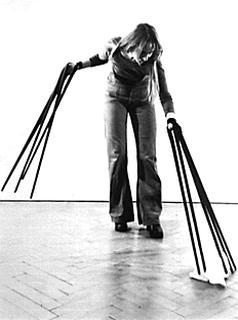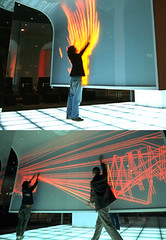At last! I've finally managed to see the Rebecca Horn retrospective at the
Centro Cultural de Belem (Lisbon, Portugal).
The experience has been strange.
Rebecca Horn was an important figure of the so-called 60's avant-garde. She was what one could call a fashion designer gone mad. She created wardrobe that changed the way the body functioned. Her
Finger Gloves (1972) are a classic, as is the
Unicorn (1970). The first one is an actual pair of gloves (shown at the Lisbon exhibition) that one puts on the fingers. They extend the fingers by a meter and half or so. Thus, one can touch distant objects, though at the same time the body seems awkward, it is hard to consider it one's own body.

The exhibition contains short films from the 70's presenting Horn's various inventions - and we can see how the Finger Gloves work, and how they impose a certain way of feeling (pardon the pun) reality. If this description reminds you of Tim Burton's charming Edward Scissorhands, you're on the right track: I'm positive Burton knows Horn's work in-depth. The Unicorn is a simple, very long cone attached to the (female, of course...) head. It seems almost trivial, but you should see the short film where the Unicorn appears and disappears on a forest road full of contrasting shadows and light spots. The oniric (dream-like) images are spell-bounding.
Upon watching this first chapter of Rebecca Horn's art, you get the feeling she was on to something. It's exciting to see her experiments, which never actually reveal any outstanding discovery, but appear to be getting ever closer... And then...
And then I don't know what happened.
Then we're back in 2005. And the world has changed. As have Rebecca Horn's sculptures. They are sophisticated, cut to perfection, well-lit and designed in the cleanest of ways. The "primitive" clock-like machines point to such nothings that we can always put something into them, the mirrors reflect just the right amount of gallery space (yes, gallery space, that's what this smells of). Even the dust is where it should be, even the ashes in the 2002 work
Book of Ashes (referring vaguely to September 11th and to the Holocaust) seem incredibly controled after the amateurish films from the 70's that contained all the freshness of a naive but vibrant faith in new art.
These new works are much more mature. They are certainly thought out and executed in a very professional way. The problem is - I shouldn't be noticing this. I should be admiring their strength and depth or craziness or peace.
Instead I go back to those early videos. They are far from perfect: watching those filmed performances I get a similar impression when I see good, but not absolutely mind-blowing contemporary works: somebody's having a party, and I get to peep in. Sometimes somebody else's party can be a great discovery. Then again, sometimes it's just a party, with too much weed and cheap philosophy (like in the mirror piece, a costume made of several mirrors which reflect the room).
Today, Rebecca Horn knows much better how to hide. Even her apparently spontaneous and "free" drawings tell me little of who she is. But I'm a difficult play-partner, and someone hiding is not in itself enough for me to seek.
With an exception:
Der Zwilling des Raben (
The Twin of the Crow), a work created in 1997, which brings Horn's old theme of feathers up-to-date, giving it - a motor.
Two wings - or two mechanical birds, two machines, are having a conversation. Two quasi-beings endlessly caress each other. They are delicate. Their black feathers fold and unfold as in a subtle dance, where resting is crucial. One of them always ends up on top. Breathing.
And only upon closer inspection does my girlfriend tell me that the feathers have been cut.
Their shape adjusted, for a more sophisticated look.








































